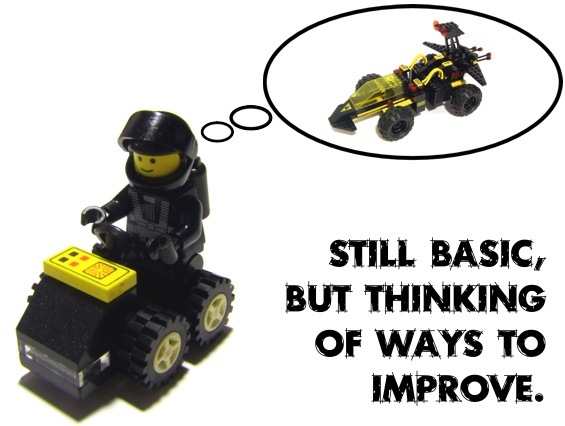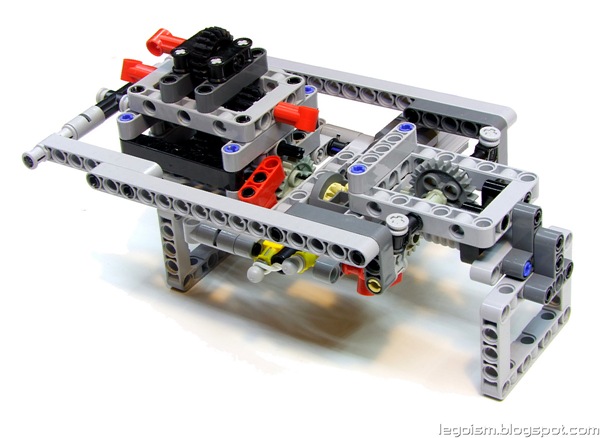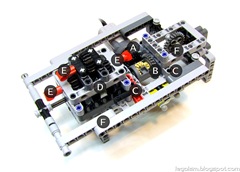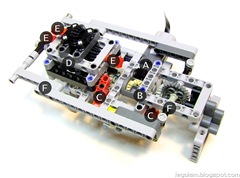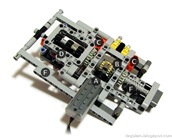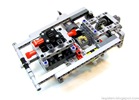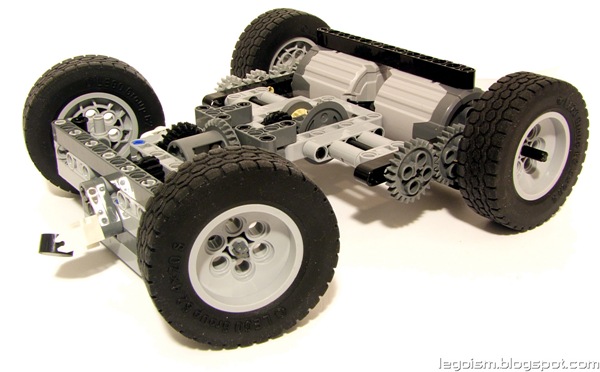
Some may remember a very simple self-steering chassis I've tested last February. It was about time to advance it, so here's a new self-steering chassis concept, Mark II.
Let's just quickly remind ourselves what the self-steering chassis is about, and when would one prefer it over typical designs. Namely, if a planned vehicle is limited to using only two motors altogether (due to weight, power requirements, size, simplicity or any other reason), a conventional approach would use one to provide drive, and the other to steer. However, for some particular models it might be troublesome to use only half the available power for providing drive.
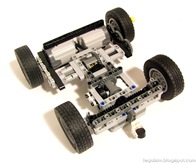 An alternative is to have both motors provide drive, one for each wheel. In such configuration, steering is done by having the two motors (and of course, their respective wheels) turn at different speeds, thus producing sufficient tangential force for the chassis to turn. This type of drive, often known as a differential drive, is used by tanks, for example. However, if the chassis is wheeled, it will turn too ― at least if the front wheels have sufficient caster to readily follow it, what was the point of the aforementioned Mark I chassis. But it still suffers from poor reliability unless perfectly balanced and having minimal friction, both of which are sometimes unavoidable. Therefore, an obvious direction for improvement is to introduce a steering control that follows the drive wheels' behaviour.
An alternative is to have both motors provide drive, one for each wheel. In such configuration, steering is done by having the two motors (and of course, their respective wheels) turn at different speeds, thus producing sufficient tangential force for the chassis to turn. This type of drive, often known as a differential drive, is used by tanks, for example. However, if the chassis is wheeled, it will turn too ― at least if the front wheels have sufficient caster to readily follow it, what was the point of the aforementioned Mark I chassis. But it still suffers from poor reliability unless perfectly balanced and having minimal friction, both of which are sometimes unavoidable. Therefore, an obvious direction for improvement is to introduce a steering control that follows the drive wheels' behaviour.
Mark II concept attempts to solve this problem mechanically. To explain its functioning, let's split it down to a few main components.
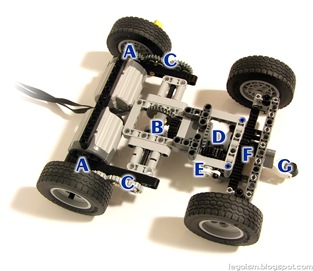 Each of the rear wheels' axles (A) is linked to a differential several studs ahead (B). As you have perhaps noticed, there are three gears (C) on one, and four at the other side, resulting in one of the axles spinning in reverse. The differential thus works opposite from its typical application on the half-axle: it actually turns only when the rear wheels aren't turning at the same speeds (i.e. they tend to steer), and its rotation speed is proportional to the difference between the rear wheels' speeds. But as long as the rear wheels turn simultaneously, it remains stationary.
Each of the rear wheels' axles (A) is linked to a differential several studs ahead (B). As you have perhaps noticed, there are three gears (C) on one, and four at the other side, resulting in one of the axles spinning in reverse. The differential thus works opposite from its typical application on the half-axle: it actually turns only when the rear wheels aren't turning at the same speeds (i.e. they tend to steer), and its rotation speed is proportional to the difference between the rear wheels' speeds. But as long as the rear wheels turn simultaneously, it remains stationary.
In other words, its turning speed is proportional to the amount of steering that needs to be done by the front wheels ― of course, also obeying the direction. But since it's the speed and not the absolute displacement we're interested in, this differential cannot be directly linked to the steering pinion. Instead, we need a simple sort of a mechanical tachometer, and that is approximately what the front differential (D) does. It has got a very light brake (E) at its main axis, and its second axle leads to a usual steering rack&pinion mechanism (F).
The point is that the brake and the rack&pinion work in balance: the more torque and speed arrive from the rear differential, the more will they be met by the increasing resistance of the brake, thus directing more towards the steering. The steering, of course, imparts its own resistance depending on how sharp turn it's attempting to make, and yet more if it's equipped with a recentering system (G). Exact steering would need a very precise balance between these variables, but in practice it needs no more than a nudge in the correct direction, and then the friction to the ground keeps it in correct geometry. In other words ― it works.
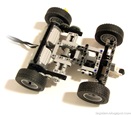 When there is no need to steer anymore (the rear wheels begin turning at the same speed), the rear differential will stop turning, and it will be easier for the front wheels to recenter themselves thanks to a bit of caster. Unless the weight on the front axle is huge and the tyres grippy, this force will be very light ― and that is the main reason why the pinion couldn't be linked to the rear differential through a standard clutch gear: its resistance would almost always be too high, and prevent the front wheels from recentering. Very heavy models may still get away with it, though ― but they rarely have limits on the number of motors anyway. The better but more complex solution is to introduce a recentering mechanism and adjust its force carefully according to the rest of the system, in which case the caster is not necessary.
When there is no need to steer anymore (the rear wheels begin turning at the same speed), the rear differential will stop turning, and it will be easier for the front wheels to recenter themselves thanks to a bit of caster. Unless the weight on the front axle is huge and the tyres grippy, this force will be very light ― and that is the main reason why the pinion couldn't be linked to the rear differential through a standard clutch gear: its resistance would almost always be too high, and prevent the front wheels from recentering. Very heavy models may still get away with it, though ― but they rarely have limits on the number of motors anyway. The better but more complex solution is to introduce a recentering mechanism and adjust its force carefully according to the rest of the system, in which case the caster is not necessary.
There are still some particular situations in which Mark II works poorly, such as turning in place (with rear wheels turning in opposite directions), turning slowly in sharp curves, and driving backwards if the steering is centered only by caster (without recentering mechanisms). However, in typical circumstances it works all right.
